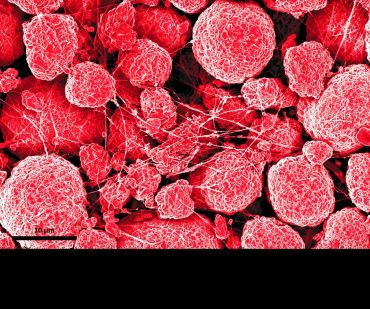
Major boost for Oxford University's battery research
Two projects led by the University of Oxford have received a major funding boost from the Faraday Institution, the UK’s flagship institute for electrochemical energy storage research. The funding is part of a £19 million investment to support key battery research projects that have the potential to deliver significant beneficial impact for the UK.
The Faraday Institution remains steadfast in its commitment to identify and invest in battery research initiatives that hold the greatest potential for making significant societal, environmental, and commercial contributions. This announcement signals the completion of our latest round of project refocusing, enabling us to allocate even more effort towards those areas of research that offer maximum potential in delivering transformative impact.
Professor Pam Thomas, CEO, Faraday Institution.
The Faraday Institution aims to drive innovation in energy storage technologies that will transform the energy landscape and make the UK the go-to place for the research and development of new electrical storage technologies. The new investment will support the reshaping of four of the Institution’s core research projects to focus on the areas with the greatest potential for success. The University of Oxford leads two of those projects.
The funding is part of a £50 million investment of government funding to 30 cutting-edge manufacturing projects, to boost the UK’s innovation of clean, green technologies, helping to create jobs and grow the economy.
Minister for Industry and Economic Security Nusrat Ghani said: ‘The UK automotive sector is at the cutting edge of exploiting innovative technologies. These have the potential to create jobs, grow the economy and accelerate how we reach net-zero. This package of funding will help industry and government work together and take decisive action in targeting areas where the UK is leading the way. This government has shown time and time again that we are committed to creating the right conditions to make the UK the best location in the world to manufacture.’
About the Oxford projects:
CATMAT – High energy density, sustainable cathode materials
Professor Saiful Islam, from the University of Oxford’s Department of Materials, leads the CATMAT project, which also includes researchers from the universities of Bath, Birmingham, Cambridge, Liverpool and UCL.
The CATMAT project is researching next-generation cathode materials that could significantly increase the energy density of lithium-ion batteries.
There is an urgent need to increase the range of electric vehicles (EVs) by developing battery materials that can store more charge at higher voltages, achieving a higher energy density. The biggest performance gains for EV lithium ion batteries in the near-term are likely to arise from changing the chemistry of the cathode. CATMAT is investigating the fundamental mechanisms acting within cathodes that currently prevent the use of nickel-rich cathode materials (with low/ no cobalt) and lithium-rich cathodes. Ultimately, this understanding could be applied to develop oxygen-redox cathode materials, where charge is stored not just on the transition metal ions but also on the oxide ions. The CATMAT team have already achieved significant breakthroughs in understanding oxygen-redox processes involved in lithium-rich cathode materials, through the use of cutting-edge methods and facilities (including the state-of-the art Diamond Light Source at Harwell Science and Innovation Campus).
We are grateful to the Faraday Institution for the ongoing support of the CATMAT project. This additional funding will allow us to build upon our successful progress towards understanding and developing solutions to the scientific barriers that are hindering the use of lithium-rich cathode materials for EV battery applications.
CATMAT project leader Professor Saiful Islam, Department of Materials, University of Oxford
The new funding will support a focused work package, the aims of which include:
- Investigate the critical properties and limitations of lithium-rich oxygen-redox cathodes and novel anion-chemistry cathodes, and develop solutions to current scientific roadblocks that hinder wider use;
- Develop new synthesis methods to facilitate scalable manufacturing routes for improved cathodes;
- Carry out experimental, modelling and cell performance evaluation to select the most promising cathodes to be taken forward;
- Synthesise cathode prototypes at small scales using scalable green synthesis routes and low energy manufacturing methods;
- Assimilate materials in full battery cells and characterise their performance in proof-of-concept devices.
Nextrode – Lithium ion battery electrode manufacturing
Nextrode researchers are developing new tools, including pre-production design and manufacturing simulation, process diagnostics, and feedback control, to reduce the manufacturing costs of Li ion battery electrodes and to improve electrode performance.
 The microstructure of a solvent-free Li ion battery cathode. Image credit: Guillaume Matthews, Oxford University.
The microstructure of a solvent-free Li ion battery cathode. Image credit: Guillaume Matthews, Oxford University.Nextrode using two approaches to develop smart manufacturing of electrodes for Li ion and related batteries. First, existing processes are being simulated with increased sophistication, with the separate process steps progressively explored for opportunities for real-time process control of electrode microstructure. New artificial intelligence tools are also being used to reveal the complex microstructure-process parameter links between successive manufacturing steps.
Second, researchers are inventing new manufacturing approaches that produce completely new electrode microstructures unachievable by today’s manufacturing plants. These smart structures are designed to allow much more of the performance of either existing or new energy storage materials to be achieved in practice. For example, a family of manufacturing processes that eliminates the use of solvents currently used in industrial manufacture are being developed with the potential to reduce cost, energy, and emissions, and provide new microstructures with higher energy storage performance.
Nextrode is led by Principal Investigator Professor Patrick Grant in the Department of Materials, University of Oxford. As well as Professor Grant’s team based at the University’s Begbroke Science Park, the Nextrode team includes researchers from the Department of Engineering Science and the universities of Birmingham, Sheffield, Southampton, Warwick and UCL, and newly joined by Imperial College London. The project partners collaborate closely with the UK Battery Industrialisation Centre.
We are tremendously excited by the continued investment of the Faraday Institution in our ideas and progress towards smarter Li ion battery manufacture. It is particularly timely given recent industrial commitments to battery manufacture in the UK. Although global competition is intense, we believe that by using a science-led approach to manufacturing we can help UK manufacturers develop novel, more sustainable and higher performing energy storage devices.
Nextrode Principal Investigator, Professor Patrick Grant, Department of Materials, University of Oxford
As part of the reshaping process, the Institution recently issued an open call for proposals for new research topics with tightly defined scopes that would strengthen the delivery of core research projects. The call was highly competitive. From that process Professor Stephen Duncan, from the University of Oxford's Department of Engineering Science, was selected to investigate whether one or more stages in the electrode fabrication process could be brought within closed loop process control, where process variables could be altered in real time to control key properties and improve battery performance.
The majority of the funding for this programme, £17.1 million, will be provided by the Faraday Battery Challenge, which is delivered by Innovate UK for UK Research and Innovation. A further £1.1 million will be provided by the Department of Science, Innovation and Technology.
The full list of projects supported by the Faraday Institution can be found on the Faraday Institution’s website.
 Landmark study definitively shows that conservation actions are effective at halting and reversing biodiversity loss
Landmark study definitively shows that conservation actions are effective at halting and reversing biodiversity loss
 Researchers find oldest undisputed evidence of Earth’s magnetic field
Researchers find oldest undisputed evidence of Earth’s magnetic field
 Honorary degree recipients for 2024 announced
Honorary degree recipients for 2024 announced
 Vice-Chancellor's innovative cross-curricular programme celebrated
Vice-Chancellor's innovative cross-curricular programme celebrated
 New database sheds light on violence in Greek detention facilities
New database sheds light on violence in Greek detention facilities